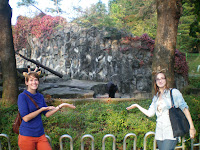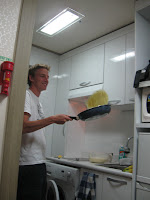After a long week of midterm exams, I needed to get out of the city. On Friday morning Philip and I headed to Gangwha-do (강 화도), an island northwest of Seoul, for another adventure! The inter-city bus was to leave from the Sinchon bus terminal, but the terminal was nowhere to be found. After 20 minutes of wandering around asking for directions, a guy came up and asked if he could help. He even walked us to our destination! It turns out that they moved the bus terminal only two months before, so we were incredibly lucky to meet someone so helpful!
 A 2.5 hour bus ride took right to the foot of Mani-san. Mani-san stands 469.4 meters tall and is the highest point on Ganghwa-do. The legendary god-king Dangun is said to have made an altar on top of Mani-san and offered sacrifices to his ancestors, and a shamanistic ceremony is still held here once a year.
A 2.5 hour bus ride took right to the foot of Mani-san. Mani-san stands 469.4 meters tall and is the highest point on Ganghwa-do. The legendary god-king Dangun is said to have made an altar on top of Mani-san and offered sacrifices to his ancestors, and a shamanistic ceremony is still held here once a year.  In typical Korean fashion, everyone was decked out in hiking attire, and Philip and I earned several odd looks for hiking in jeans and sweaters. The view at the top, while crowded with people, was fantastic.
In typical Korean fashion, everyone was decked out in hiking attire, and Philip and I earned several odd looks for hiking in jeans and sweaters. The view at the top, while crowded with people, was fantastic. And, after hiking, don't forget to vacuum your shoes!
The weekend occurred mainly without a plan, just with a vague idea of what we wanted to see and do. A trip to Seokmo-do (석모도), an island off of the coast of Ganghwa that is home to the famous Bomunsa (보문사) temple, and some exploring in the fishing village of Oepo-ri were high on the list, so we headed towards the coast as the sun set. "Red sky at night, sailor's delight. Red sky at morning, sailor's take warning!" With the intensity of the sky's red, I went to sleep with high hopes of beautiful weather for the next day's exploring! (And a full belly of giant fried tiger shrimp - I love seafood!)
 The next morning, a few hundred meters from the motel, I noticed a path a path lead into a wooded hill. I can't resist exploring, so we scrambled up the hill and came upon this fort! The Mangyang Dondae fortress was built in 1679 to protect the town from enemies. And the doors were very short.
The next morning, a few hundred meters from the motel, I noticed a path a path lead into a wooded hill. I can't resist exploring, so we scrambled up the hill and came upon this fort! The Mangyang Dondae fortress was built in 1679 to protect the town from enemies. And the doors were very short. Just below the fortress, the pine-tree covered hill met the rocky shoreline, and we couldn't help but dally there for a while, listening to the sounds of the ferries, the seagulls, and the waves. How far away Seoul seemed!
A short and beautiful ferry ride (2,000 won roundtrip!) brought us to Seokmo-do, where a bus (1,000 won) dropped us in front of the entrance to Bomunsa. Old women lined the street, selling an odd variety of vegetables, fruits, and herbs, and well-attired Korean tourists swarmed everywhere. I was quite excited, because I conducted a successful purchase of tickets - asking the price, requesting tickets, and giving payment - all in Korean!
A very steep walk uphill brought us to the temple complex. People were tossing coins onto the pagoda as if it were a wishing fountain. I tossed a coin with the Trevi Fountain in mind, and my coin found a home on my first try. :) In the pictures below, check out how all of the little men were uniquely painted. In the picture on the right, a man seems to have a little blue demon on his lap! (You can click on a picture to make it bigger!)
 A steep flight of stairs led up to a 10-meter-tall carving of a seated Buddha, where women and their mothers go to pray for the birth of a son. After sweating and panting my way up, I was impressed to see many older women serenely performing their series of 108 bows. I've read somewhere that Bomunsa is considered one of the most sacred places in South Korea, and it certainly was beautiful and awe-inspiring.
A steep flight of stairs led up to a 10-meter-tall carving of a seated Buddha, where women and their mothers go to pray for the birth of a son. After sweating and panting my way up, I was impressed to see many older women serenely performing their series of 108 bows. I've read somewhere that Bomunsa is considered one of the most sacred places in South Korea, and it certainly was beautiful and awe-inspiring.After hiking up and down the mountain of Bomunsa, Philip and I were in desperate need of sustenance (both of us get cranky when hungry). An outdoor, traditional (sit-on-the-floor) Korean restaurant at the foot of the mountain with a stream running past it served us sanchae bibimbap (fresh local vegetables served with rice and spicy sauce,) panjeon (파 전, Korean green onion pancake), and many side dishes. A feast!
And what would a trip to an island off of an island be without a ride on a scooter? We drove through trees on the hills and fields by the sea. Flowers lined the road, the sun shone, and the air smelled of the harvest.
Eventually we took the ferry back to Ganghwa-do, and, following the crowd of Korean tourists, caught a bus to Ganghwa-eup, the island's main town. From there, our final act on the island was to visit the Ganghwa dolmen. Dolmen are tombs from the 1st millennium BC that are constructed of large stone slabs. The largest and most famous (UNESCO World Heritage Site!) dolmen weights somewhere between 150 and 225 tons. It was very old and very big, and I was very cold.
From the dolmen, we journeyed back to Ganghwa-eup and home to Seoul. The wonderful weekend adventure ended with a chocolate cake at Paris Baguette, where Philip and I marveled at how much our jaws hurt from smiling too much. Only 36 hours had passed, but we'd explored so much and I felt totally refreshed!


























































